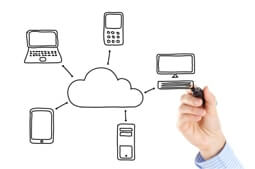 There has been a lot of talk lately about “the Cloud” and what it all means for businesses. “The Cloud” also tends to go hand-in-hand with discussions about SaaS (software-as-a-service) and most recently True SaaS.
There has been a lot of talk lately about “the Cloud” and what it all means for businesses. “The Cloud” also tends to go hand-in-hand with discussions about SaaS (software-as-a-service) and most recently True SaaS.
But what are the differences – and how can you benefit from it all as an organization in our evolving staffing industry? Starting this month, we’re going to begin a series to help educate you on the Cloud by looking at the advantages of cloud-based solutions, as well as bring forward the industry perspective and information you need to make the right decision for your company.
We’ll start with John Zappe at ere.net who published a great article outlining advantages of SaaS solutions. The article Thinking SaaS? Considering the Cloud? Here’s What You Should Know, provided a clear summary of what SaaS has to offer, which included these advantages from his article:
Price: Usually a monthly fee, quoted on a per seat or per user basis. The initial outlay is dramatically lower for SaaS than for an on-premise license. That has tax benefits since it is treated as an operating expense, and it helps conserve cash.
Installation: This can take from a few days to a few weeks — longer in some limited instances. Most of the time is in uploading data to the vendor, training, and in (the limited) customization of the user interface and reports.
System management: The vendor is responsible for keeping the system up and running, fixing bugs, and installing upgrades. The most common update (not upgrade) schedule is monthly.
Accessibility: Because the cloud is Internet based, SaaS operating in that environment makes it possible to access the data anywhere at any time, and, as vendors add mobile capability, on any platform.
Security: The vendor is responsible. Because IT security professionals are scarce and expensive, vendors can more easily hire them and spread the cost over the entire customer base.
Applications: With apps becoming ever more ubiquitous, cloud computing is a more felicitous method for integrating them with a vendor’s software. These integrations, which vendors tout as partnering, make it simple for an HR unit to begin using a third-party provider for such things as background checks, I-9 verifications, payroll, and the like.
Service: An oft-overlooked advantage to SaaS is the flexibility customers have to change vendors. While switching is always a hassle, cloud computing means a business is not tied to a particular vendor or system.
Innovation: Because there is one version of the vendor’s software powering all the company’s subscribers, developing new features and implementing them is easy, compared to an on-premises installation. The cost of the development and implementation is spread across the entire base, encouraging innovation. There’s also the vendor’s ability to effectively monitor how the product is being used. In most cases, vendors get little usage data from installed software. But a SaaS operation can provide gigabytes about what users do with the product.
Scalability: Growth is rarely an issue. One of the hallmarks of cloud computing is that the storage and usage is, at least theoretically, unlimited. You’ll pay for what you use, but when you need it, the capacity is there.
You can read more about John’s thoughts on SaaS in the full article Thinking SaaS? Considering the Cloud? Here’s What You Should Know.
It’s obvious the industry is shifting towards easier-to-use solutions as a way of running business; ones that allow for fast setup and eliminate the need for time-consuming upgrades and updates. Customers are frustrated with single-user software that may be installed on a server, limiting collaboration and segmenting front and back office operations.
In future posts we’ll support the idea of conducting business in the Cloud and how leveraging True SaaS products, like AkkenCloud’s Cloud-based All-in-One solution, could be the perfect fit for your organization. We’ll more closely review the differences between SaaS offerings, and share some examples of how our own customers are benefiting from those differences.

